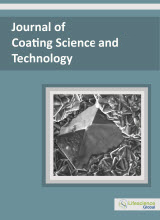jcst
Abstract : The Effects of Primary Oxy-Salts on Anodizing Magnesium Alloy AZ91D
|
|
|
Abstract: Anodization is known to be an effective way to slow down the initial corrosion rate of magnesium (Mg) and its alloys. Here, we investigated the specific use of oxy-salts to improve the corrosion resistance of anodizing coatings. Oxy-salts of silicate, phosphate, and carbonate were added separately to a sodium hydroxide alkaline electrolyte used to anodize Mg alloy AZ91D. The process was investigated in terms of anodizing behavior, the surface properties, and the corrosion behavior of AZ91D. Anodizing AZ91D using the silicate- containing electrolyte generated sparks, and produced a thicker and more corrosion-resistant layer than the other oxy-salts. In the process, MgO and SiO2 formed Mg2SiO4 at high temperatures. Coatings from the phosphate- and carbonate- containing electrolyte anodizations did not contain phosphorus or carbon. We also studied the effects of silicate concentration on the corrosion resistance and properties of the surface. Keywords: Anodization, corrosion, AZ91D, primary oxy-salt. |
Abstract : Bacterial Anti-Adhesion of Coated and Uncoated Thin-Film-Composite (TFC) Polyamide (PA) Membranes
|
|
|
Abstract: This study investigates the bacterial anti-adhesion performance of uncoated and coated reverse osmosis (RO) membranes. All the membranes were commercially available fully-aromatic thin-film-composite (TFC) polyamide (PA) membranes. Two of the TFC PA membranes (SW30 and BW30) were coated using polyvinyl alcohol (PVA) coating, while the other three membranes (LE, XLE and NF90) were uncoated. Among the characterised TFC PA membranes, the PVA coated were more hydrophilic and their surface energy was higher in comparison to uncoated. In addition, the PVA coated membranes had lower surface roughness. AFM interaction force measurement demonstrated higher repellence performance for the more polar surface. Bacteria attachment test showed differences between the coated and the uncoated membranes. Indeed, the increase in hydrophilicity and surface polarity showed decrease in the attachment of Pseudomonas aeruginosa cells. Moreover, the results demonstrated that the surface polarity showed better correlation with the attachment of the bacteria. In addition, the type of the surface roughness may somehow contribute to the bacteria repellence. Keywords: Thin film composite (TFC) polyamide (PA) membrane, polyvinyl alcohol (PVA), surface energy, topography, biofouling. |
Abstract : Sol-Gel Derived Single Layer Zeolite-MgF2 Composite Antireflective Coatings with Improved Mechanical Properties on Polycarbonate
|
|
|
Abstract: Single layer antireflective coatings with good optical and mechanical properties are difficult to be obtained on temperature sensitive substrates like plastics. This challenge has been taken up in the present study. Single layer MgF2 and for the first time, zeolite 4Å and zeolite 4Å - MgF2 composite antireflective coatings were generated by a wet chemical route on flat polycarbonate sheets and characterized for their reflectance, surface roughness, thickness, porosity, surface morphology and scratch hardness by haze measurement. Autoclaving and boiling water treatment under microwave irradiation were used in case of MgF2 sols and zeolite/zeolite-MgF2 coatings respectively. Pure MgF2 coatings deposited after autoclaving of the MgF2 sol yielded a low refractive index of 1.28 and an average reflectance of 1.9% vis-à-vis 9.7% reflectance for an uncoated polycarbonate substrate over the wavelength range of 400-1100 nm. Single layer zeolite coatings after a brief treatment in boiling water under microwave irradiation yielded a reflectance of 5.1%. A composite zeolite-MgF2 coating exhibited a reflectance of 2.8% and the percentage change in haze after crockmeter testing in case of the composite coating was lower than that of a pure MgF2 coating. This implied that the composite layer had improved mechanical properties combined with good optical properties and could be suitable for practical applications. Keywords: Sol-gel Process, Zeolite-MgF2, Antireflective coatings, Mechanical properties, Optical properties. |
Abstract : Microstructure Effects on Electrochemical Characteristics for Plasma Spray Deposited LiFePO4 Films
|
|
|
Abstract: The electrochemical behavior of composite electrodes used in Li ion batteries is influenced by factors such as microstructural characteristics (e.g. particle size, crystallinity, porosity etc.) and composition. For optimal performance of electrodes these factors are of utmost concern and serve as motivation for research in this field. In this report, we investigated LiFePO4 films synthesized by a novel plasma spray deposition method, which has capability for direct deposition of LiFePO4 films with carbon. This enables electrode characterizations to be carried out at the film level, without recourse to steps involving powder material handling. In this report microstructure and electrochemical properties of LiFePO4 films were investigated to elucidate their unique characteristics. Our studies show that factors such as porosity and microstructure of the films affect the electrochemical properties. The mechanical compression and thermal annealing experiments are shown to affect the electrochemical characteristics of LiFePO4 films. We show that annealing treatment leads to a drastic improvement in impedance and charge-discharge capacities for the LiFePO4 films. These treatments could serve to improve the electrode properties of porous film based materials for Li ion batteries and help us develop new film based materials for energy storage applications. Keywords: Plasma spray, LiFePO4 films, Mechanical compression, thermal annealing, Electrochemical Impedance spectroscopy. |























